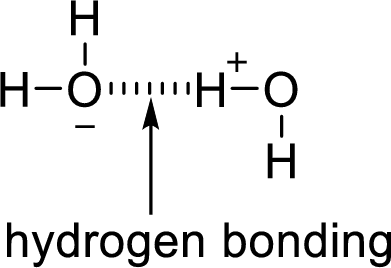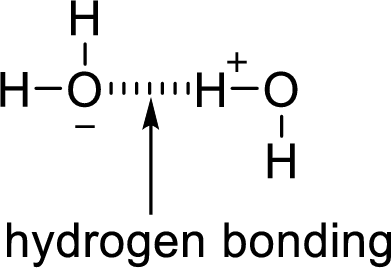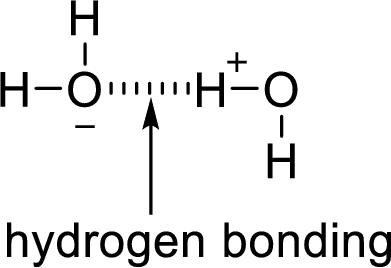
Concept explainers
(a)
Interpretation:
From the given compounds, compounds with higher value of solubility has to be identified and the reason for the higher value of solubility has to be explained.
The given compounds are chloroethane and methylethylamine.
Concept Introduction:
The physical properties are determined by the intermolecular forces, polarity of the compound and hydrogen bonding. If a compound is polar and have hydrogen bonding, the solubility will be more for that compound than in non-polar compounds.
Intermolecular forces:
The forces which acts in between the atoms to hold a molecule are said to be intermolecular forces. They are weak forces. Intermolecular forces are categorized as hydrogen bonding, ionic bonding, ion-induced dipole forces, ion-dipole forces and Vanderwaal forces.
Hydrogen bonding:
The attraction between a lone pair of hydrogen atom with that of an electronegative atom forms hydrogen bonding. Two water molecules are held together by hydrogen bond.

(b)
Interpretation:
From the given compounds, compounds with higher value of melting point has to be identified and the reason for the higher value of melting point has to be explained.
The given compounds are diethyl ether and 1-butanol.
Concept Introduction:
The physical properties are determined by the intermolecular forces, polarity of the compound and hydrogen bonding. If a compound is polar and have hydrogen bonding, the melting point will be more for that compound than in non-polar compounds.
Intermolecular forces:
The forces which acts in between the atoms to hold a molecule are said to be intermolecular forces. They are weak forces. Intermolecular forces are categorized as hydrogen bonding, ionic bonding, ion-induced dipole forces, ion-dipole forces and Vanderwaal forces.
Hydrogen bonding:
The attraction between a lone pair of hydrogen atom with that of an electronegative atom forms hydrogen bonding. Two water molecules are held together by hydrogen bond.

(c)
Interpretation:
From the given compounds, compounds with higher value of boiling point has to be identified and the reason for the higher value of boiling point has to be explained.
The given compounds are trimethylamine and propylamine.
Concept Introduction:
The physical properties are determined by the intermolecular forces, polarity of the compound and hydrogen bonding. If a compound is polar and have hydrogen bonding, the boiling point will be more for that compound than in non-polar compounds.
Intermolecular forces:
The forces which acts in between the atoms to hold a molecule are said to be intermolecular forces. They are weak forces. Intermolecular forces are categorized as hydrogen bonding, ionic bonding, ion-induced dipole forces, ion-dipole forces and Vanderwaal forces.
Hydrogen bonding:
The attraction between a lone pair of hydrogen atom with that of an electronegative atom forms hydrogen bonding. Two water molecules are held together by hydrogen bond.

Want to see the full answer?
Check out a sample textbook solution
Chapter 15 Solutions
MOLECULAR NATURE OF MATTER ALEKS ACCESS
- Calculate the pH and the pOH of each of the following solutions at 25 °C for which the substances ionize completely: (a) 0.000259 M HClO4arrow_forwardWhat is the pH of a 1.0 L buffer made with 0.300 mol of HF (Ka = 6.8 × 10⁻⁴) and 0.200 mol of NaF to which 0.160 mol of NaOH were added?arrow_forwardDetermine if the following salt is neutral, acidic or basic. If acidic or basic, write the appropriate equilibrium equation for the acid or base that exists when the salt is dissolved in aqueous solution. If neutral, simply write only NR. Be sure to include the proper phases for all species within the reaction. NaN₃arrow_forward
- A. Draw the structure of each of the following alcohols. Then draw and name the product you would expect to produce by the oxidation of each. a. 4-Methyl-2-heptanol b. 3,4-Dimethyl-1-pentanol c. 4-Ethyl-2-heptanol d. 5,7-Dichloro-3-heptanolarrow_forwardWhat is the pH of a 1.0 L buffer made with 0.300 mol of HF (Ka = 6.8 × 10⁻⁴) and 0.200 mol of NaF to which 0.160 mol of NaOH were added?arrow_forwardCan I please get help with this.arrow_forward
- Determine if the following salt is neutral, acidic or basic. If acidic or basic, write the appropriate equilibrium equation for the acid or base that exists when the salt is dissolved in aqueous solution. If neutral, simply write only NR. Be sure to include the proper phases for all species within the reaction. N₂H₅ClO₄arrow_forwardPlease help me with identifying these.arrow_forwardCan I please get help with this?arrow_forward
 ChemistryChemistryISBN:9781305957404Author:Steven S. Zumdahl, Susan A. Zumdahl, Donald J. DeCostePublisher:Cengage Learning
ChemistryChemistryISBN:9781305957404Author:Steven S. Zumdahl, Susan A. Zumdahl, Donald J. DeCostePublisher:Cengage Learning ChemistryChemistryISBN:9781259911156Author:Raymond Chang Dr., Jason Overby ProfessorPublisher:McGraw-Hill Education
ChemistryChemistryISBN:9781259911156Author:Raymond Chang Dr., Jason Overby ProfessorPublisher:McGraw-Hill Education Principles of Instrumental AnalysisChemistryISBN:9781305577213Author:Douglas A. Skoog, F. James Holler, Stanley R. CrouchPublisher:Cengage Learning
Principles of Instrumental AnalysisChemistryISBN:9781305577213Author:Douglas A. Skoog, F. James Holler, Stanley R. CrouchPublisher:Cengage Learning Organic ChemistryChemistryISBN:9780078021558Author:Janice Gorzynski Smith Dr.Publisher:McGraw-Hill Education
Organic ChemistryChemistryISBN:9780078021558Author:Janice Gorzynski Smith Dr.Publisher:McGraw-Hill Education Chemistry: Principles and ReactionsChemistryISBN:9781305079373Author:William L. Masterton, Cecile N. HurleyPublisher:Cengage Learning
Chemistry: Principles and ReactionsChemistryISBN:9781305079373Author:William L. Masterton, Cecile N. HurleyPublisher:Cengage Learning Elementary Principles of Chemical Processes, Bind...ChemistryISBN:9781118431221Author:Richard M. Felder, Ronald W. Rousseau, Lisa G. BullardPublisher:WILEY
Elementary Principles of Chemical Processes, Bind...ChemistryISBN:9781118431221Author:Richard M. Felder, Ronald W. Rousseau, Lisa G. BullardPublisher:WILEY





